With the massive proliferation of greens powders by the industry today, we should all be asking ourselves: what is the real nutritional value of these products? Can just a couple tablespoons of dried fruits or vegetables really have much of a positive effect on our health? What differentiates these products from one other? What advantages do they offer over just consuming ordinary fruits and vegetables that you buy at the grocery store?
These are questions worth asking in any case, but especially given the price point of these supplements: dried whole-food powders can often cost upwards of $50 a bag, so you want to be sure you're getting big benefits for your dollar.
As a service to consumers who are concerned about value, PEScience asked all of these questions -- and then answered them.
Exotic Reds & Blues: Powerful Anthocyanins & Carotenoids
With PEScience Exotic Reds and Blues, you get a powerful "red" counterpart to pair with their unique PEScience Greens & Superfoods that were released in 2020. We dig deep into the anthocyanins and carotenoids in this interesting Reds and Blues formula below, but first, check PricePlow's coupon-based prices and subscribe to our PEScience news alerts:
PEScience Exotic Reds & Blues – Deals and Price Drop Alerts
Get Price Alerts
No spam, no scams.
Disclosure: PricePlow relies on pricing from stores with which we have a business relationship. We work hard to keep pricing current, but you may find a better offer.
Posts are sponsored in part by the retailers and/or brands listed on this page.
This area is reserved for Team PricePlow's upcoming Ingredients video.
Subscribe to our channel and sign up for notifications so you catch it when it goes live!
We'll do an individual ingredient breakdown for Exotic Reds & Blues, but because the supplement contains so many powerful ingredients, it will be more efficient for us to first talk about the properties of the two fundamental classes of bioactive compounds each have in common:
-
Anthocyanins: A Powerful Weapon against Big Diseases
Many of our favorite fruits and vegetables -- blueberries, raspberries, pomegranates, beets -- are rich in anthocyanins, a class of polyphenol molecules[1] that imbue plants with red and blue (hence the product name) hues. Anthocyanins are crucial to the health and function of the plants where they occur, aiding in propagation and defense against herbivores,[1] but it turns out they're great for human health as well.
At the outset, it should be noted that anthocyanins are insanely powerful antioxidants,[2] helping to prevent our DNA from being damaged by oxidative stress.[2] But these days in the nutritional supplement industry, antioxidant supplements seem like they're a dime a dozen -- so with that out of the way, let's talk about some of the more specific and unique benefits that anthocyanins have on human health.
First of all, anthocyanins have amazing antimicrobial activity: anthocyanins inhibit the growth of bacteria on so many different levels that it really is as if they were designed to do it. Anthocyanins attack microbes directly, by breaking down cell walls, interfering with their mitochondrial function, and deactivating enzymes that microbes rely on to survive,[2] but they also attack microbes indirectly, by destroying the substrates that microbes need for food.[2]
So it's no surprise that anthocyanin-rich extracts of cranberry, elderberry, blueberry, and bilberry inhibited the growth of Helicobacter pylori by a whopping 90%.[2] That's a big deal, because H. pylori has been linked to several diseases of the gastrointestinal tract, including gastritis, cancer, and ulcers.[3]
Anthocyanins are also profoundly anti-inflammatory -- they actually suppress the expression of genes that the body uses to create inflammatory molecules.[2] Among the inflammatory molecules downregulated by anthocyanins are the prostaglandins, the same target of world-famous anti-inflammatory drug aspirin. One study, comparing anthocyanin extracts to aspirin, found that anthocyanins actually did better than aspirin at preventing systemic inflammation[4], which, if you think about it, says truly amazing things about the power of anthocyanins.
When it comes to diabetes, anthocyanins continue to shine: adipocyte inflammation, a type of cellular dysfunction that's linked to metabolic syndrome and obesity, significantly improves by administering anthocyanins.[5] That's possibly because anthocyanins increase the expression of a hormone called adiponectin, which is responsible for increasing whole-body insulin sensitivity and promoting glucose uptake in muscle tissue.[2] Since adiponectin levels typically decrease in cases of obesity,[2] administering anthocyanins could potentially help interrupt the vicious cycle of insulin resistance and hyperglycemia.
To be honest, all of this is just scratching the surface of anthocyanins' incredible range of benefits for human health -- but I think we can all agree that for most people living in Western societies, inflammation, diabetes, and gastrointestinal disease are extremely common concerns. Since anthocyanins have shown clear benefits for these conditions, anthocyanin-rich foods and supplements are a worthy addition to almost anybody's diet.
-
Carotenoids: Vitamin A precursors, Vision protection, UV absorption
Whereas anthocyanins give plants colors from the red/blue end of the color spectrum, carotenoids give them colors from the red/yellow end. As an example, the vegetable from which carotenoids got their name -- the carrot -- is bright orange. However, carotenoids are not exclusive to plants: they can be found at high concentrations in butter and egg yolks.[6] You find carotenoids in these animal fats because while anthocyanins are water-soluble, carotenoids are fat-soluble,[6] so if you really want to maximize your absorption of carotenoids from Exotic Reds & Blues or any other source, you should always consume them with a generous serving of healthy dietary fat.
For stacking: PEScience Greens & Superfoods features a unique formula for optimal benefits!
One thing that carotenoids have in common with anthocyanins is their antioxidant activity.[7] Probably because of their anti-inflammatory effect,[6] having a high carotenoid intake has been linked to healthy body composition[6] and a lower incidence of cardiovascular disease.[6] So in many ways, carotenoids have effects on the body similar to those of anthocyanins.
For carotenoid-specific effects on the human body, we will turn to the discussion of lutein and beta-carotene, two carotenoids that are highly concentrated in acerola powder, which is one of the main ingredients in Reds & Blues from PEScience.
Beta-carotene is a vitamin A precursor,[8] meaning that the body will convert beta-carotene in a rate-limited fashion into the active form of vitamin A, which is retinol. It's crucial to get enough vitamin A because a deficiency in this vitamin can cause a wide range of health problems, from immune dysfunction to metaplasia.[8] Carotenoid-rich diets have been linked repeatedly to a lower risk of macular degeneration[9] and cataracts,[10] two common diseases of the eye. Low vitamin A status is also recognized as a risk factor for heart disease.[11]
Moreover, high intakes of beta-carotene and other carotenoids can actually help protect human skin from damage after exposure to ultraviolet light.[12]
"But wait," one might ask, "What are the chances I'm not getting enough vitamin A? Do I really need to supplement?" As it turns out, the chances you're not getting enough A are quite likely: when the CDC conducted their 2005-2016 National Health and Nutrition Examination (NHANES) survey, they found that about 45% of the American public doesn't get enough vitamin A from their diets.[13]
The risk of vitamin A overdose from carotenoid intake is low, and carotenoids are recognized to be "generally nontoxic."[14] However, out of an abundance of caution, we at PricePlow warn people taking any vitamin A supplement to consider their overall vitamin A intake, and to be sure it does not exceed the recommended daily limit.
When it comes to lutein, one of only two carotenoids capable of crossing the brain-blood barrier, we see some extremely interesting effects on human vision and cognition. Usually we try to paraphrase research for the sake of brevity, but this excerpt was so interesting that we had to include it as a direct quote from a 2013 article published in Advances in Nutrition:[14]
"For example, because carotenoids absorb light, they can also influence the optical characteristics of the human eye. Lutein and zeaxanthin concentrate in the inner layers of the macular region of the eye (there, they are referred to as macular pigment). Macular pigment selectively absorbs the lower third of the visible spectrum (400–500 nm, peak absorbance = 460 nm). By forming an internal yellow filter that screens cones, a number of optical improvements occur. For example, by filtering scattered short-wave light, glare disability and discomfort are lessened... Light energy is inversely related to wavelength. Hence, by screening the energetic shorter wavelengths of light, actinic damage to the outer retina is reduced, whereas photostress recovery, chromatic contrast, and visual range are increased."[14]
This protective, filtering effect of lutein on the brain's ocular system is so powerful that it is believed to improve cognition, especially in older people.[15]
Ingredients
In one 5.5 gram scoop of Exotic Reds & Blues from PEScience, you get the following:
-
Reds & Blues blend - 3,000 mg
See the section above to discuss the benefits of the blend. This blend contains the following:
Freeze-dried strawberry powder, blueberry juice powder, freeze-dried maqui berry powder, MicroDried cranberry powder, freeze-dried pomegranate juice powder, jabuticaba juice powder, MicroDried beet root powder, freeze-dried dragon fruit powder, MicroDried aronia fruit powder, and freeze-dried acai powder.
-
Concentrated Antioxidant Blend - 130 mg
See the section above to discuss the benefits of the blend. This blend contains the following:
Acerola fruit juice powder, pomegranate fruit extract, blueberry fruit extract, grape seed extract, acai fruit extract, and turmeric root extract.
-
Inositol - 2,000 mg
Inositol is a unique carbohydrate that's found primarily in the brain. Although once thought to be an "essential" carbohydrate, meaning a carbohydrate the body cannot synthesize and must obtain in a complete form from food, inositol has since been shown to be synthesized in the kidneys and liver. In the brain, inositol helps to both regulate neurotransmitters and maintain the integrity of cell membranes.[16,17] Research shows that poor mental performance is sometimes caused by low levels of inositol in the brain,[18] and that supplementation of inositol can improve cognitive function by increasing the production of dopamine and serotonin.[17]
Flavors Available
In case PEScience ends up putting any flavored versions out, here are the variations PricePlow has seen:
Stacking
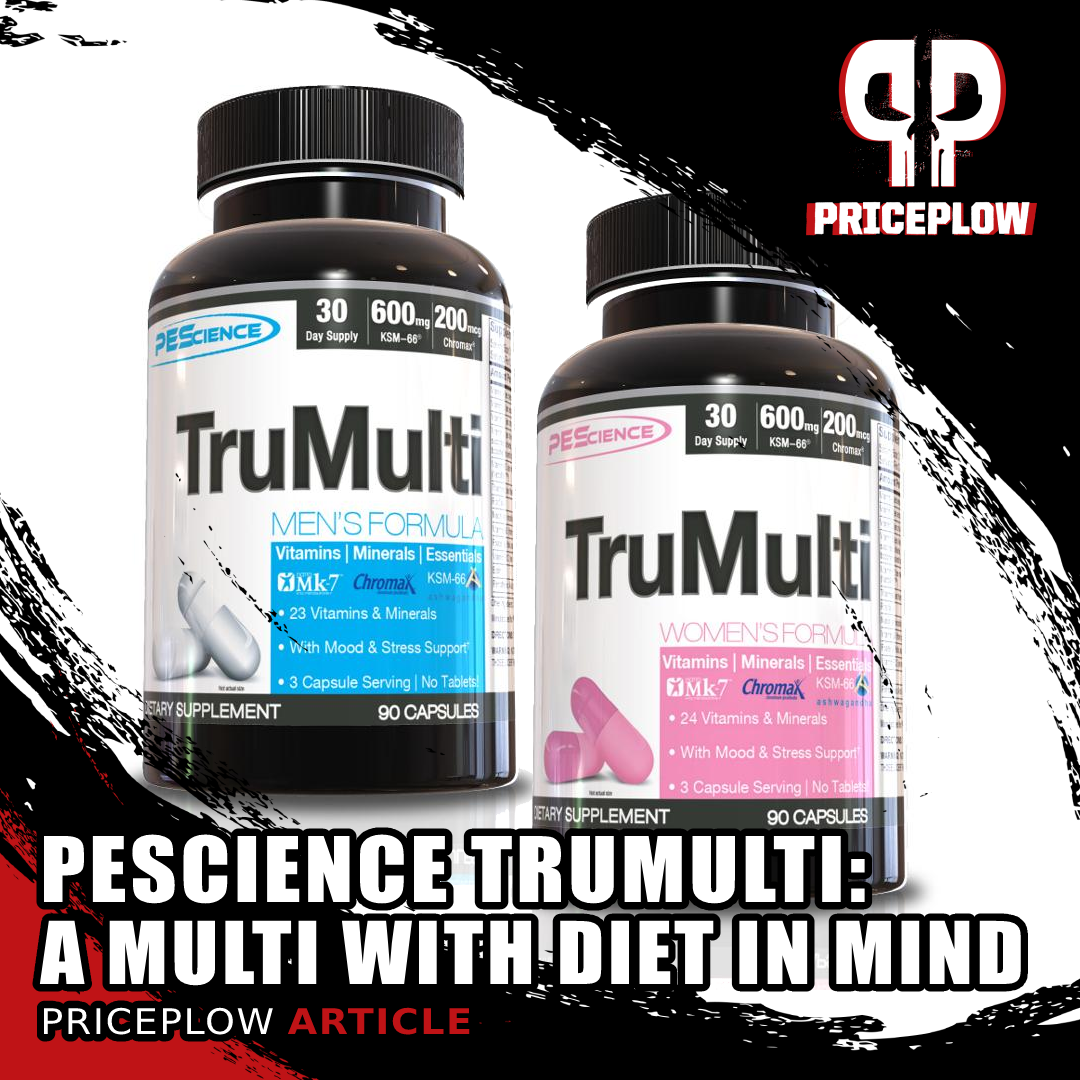
With KSM-66 Ashwagandha and Nutrition21's Chromax Chromium Picolinate, the PEScience TruMulti Series is a multivitamin with diet support in mind
The great thing about Exotic Reds & Blues is that it was designed to be stacked with some other phenomenal products from PEScience, such as their Greens & Superfoods powder, which is more antioxidant, performance, and micronutrient focused. If you want to stack the benefits of reds, blues and greens with a more traditional vitamins and minerals approach to supplementation, you could stack all three of them with the PEScience TruMulti multivitamin -- when you're dealing with a company as innovative and prolific as PEScience, the possibilities are truly endless.
Want to think about your stacking options? Head over to our PEScience brand news page and take a look at their product catalog: PEScience News, Reviews, & Prices at PricePlow
Greens are good, but don't forget to get your Reds
There's a saying in nutrition these days that you should try to "eat the rainbow" -- that is, to consume a wide enough variety of food that every color of the rainbow is represented in your diet. The very good reason for this is that color indicates the specific antioxidant and phytochemical profile of any given plant, and for optimal health, you want to make sure that you're consuming the widest possible range of beneficial compounds.

See our PEScience page to compare prices on all of their excellent supplements!
So, regardless of whether you're taking a greens supplement, or which one you're taking, Exotic Reds & Blues from PEScience is an excellent addition to your diet and your supplement routine. This is a unique product that focuses on a section of the rainbow that isn't typically represented in the supplement market: the red, blue, and purple part, where your anthocyanins and carotenoids will reside.
PEScience Exotic Reds & Blues – Deals and Price Drop Alerts
Get Price Alerts
No spam, no scams.
Disclosure: PricePlow relies on pricing from stores with which we have a business relationship. We work hard to keep pricing current, but you may find a better offer.
Posts are sponsored in part by the retailers and/or brands listed on this page.
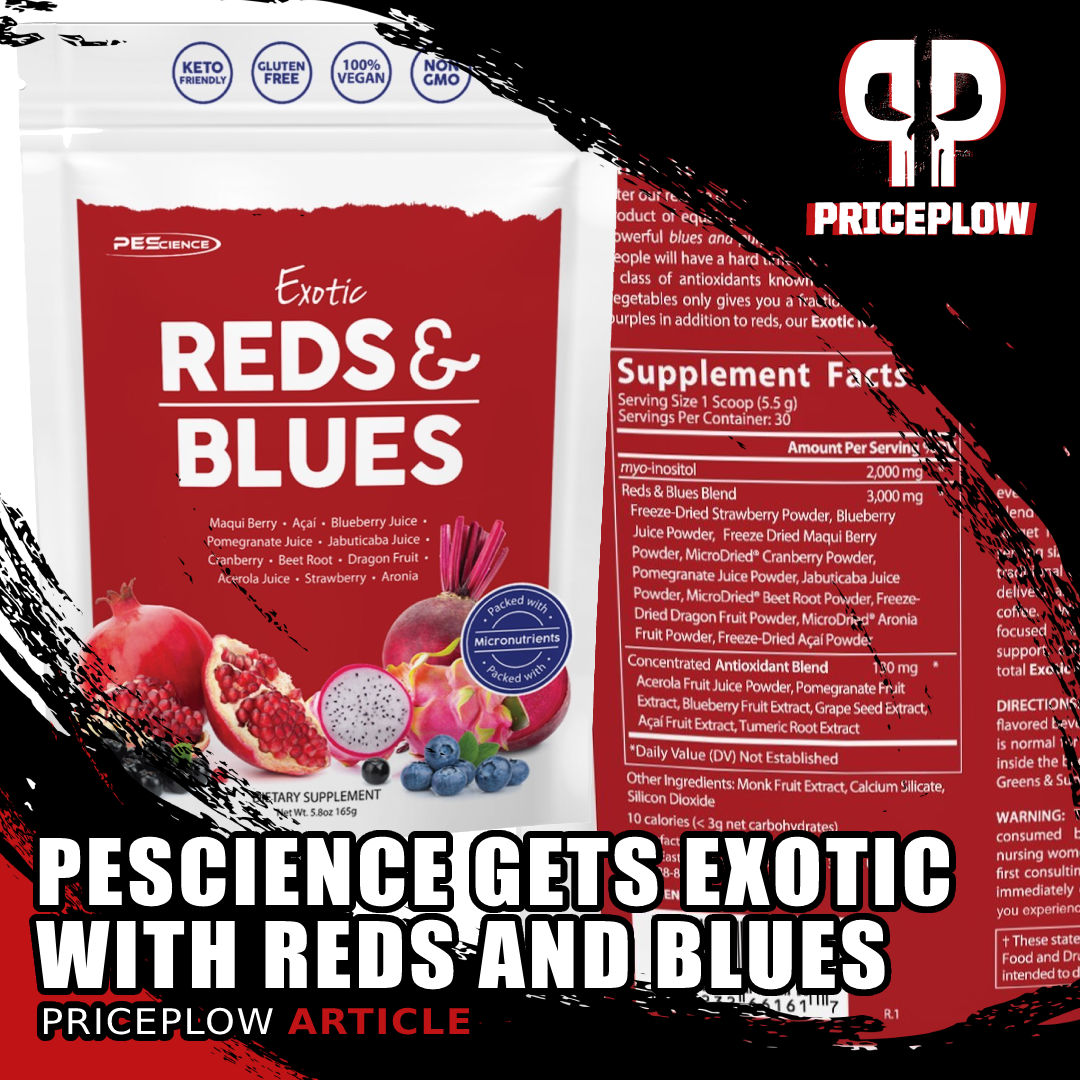
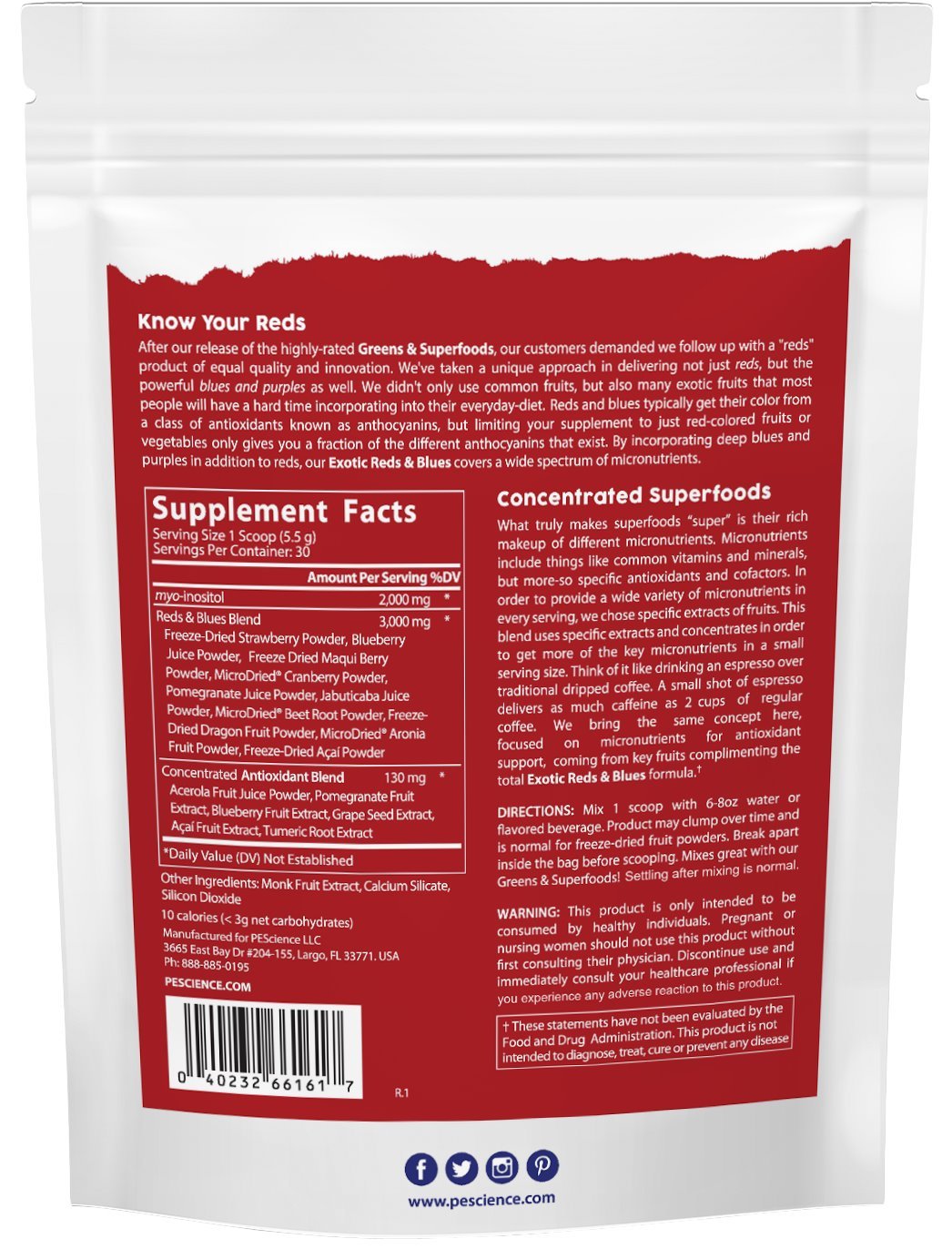
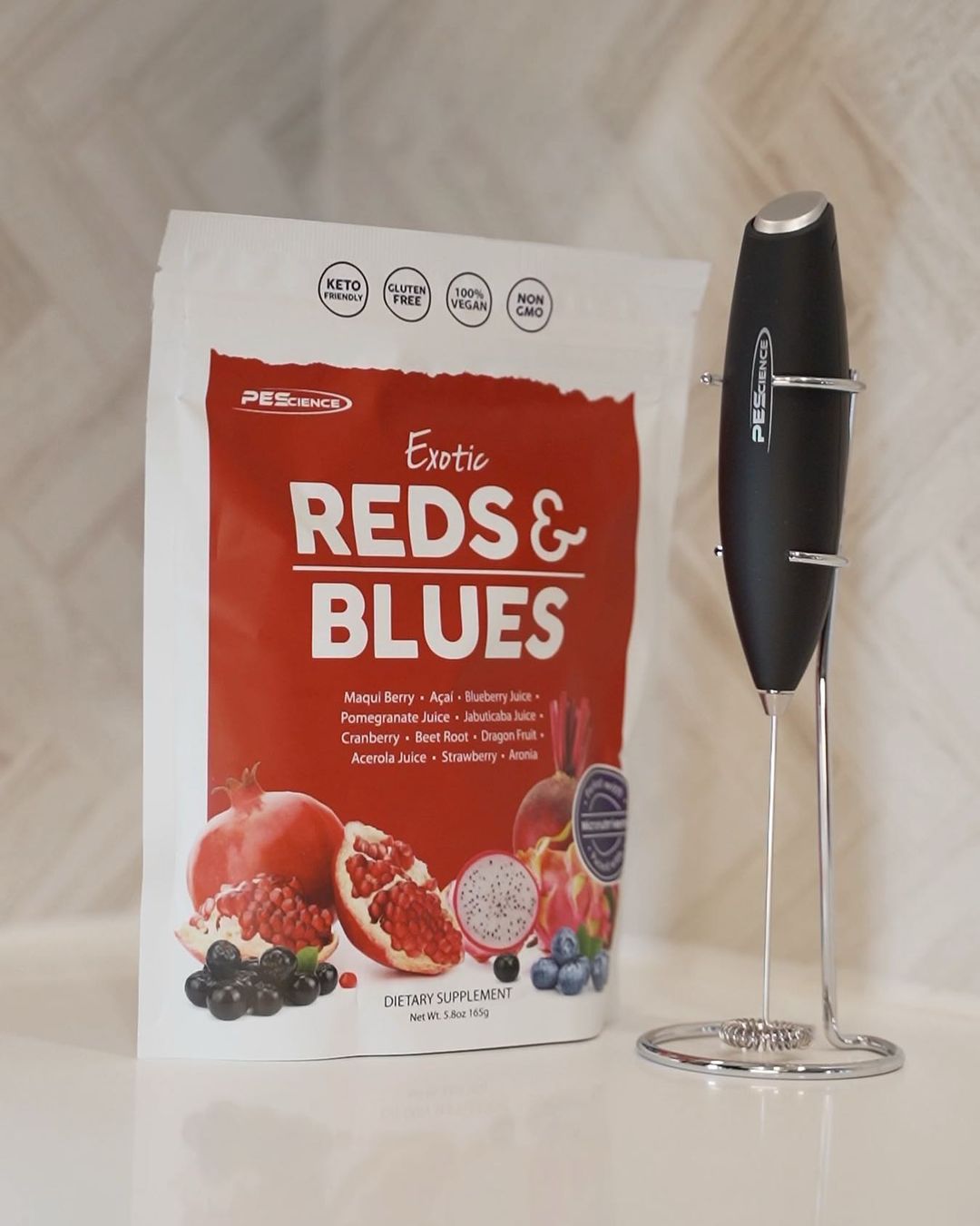
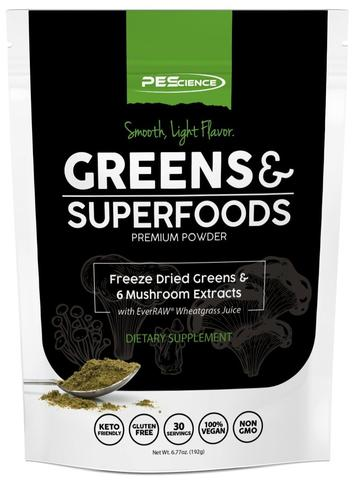
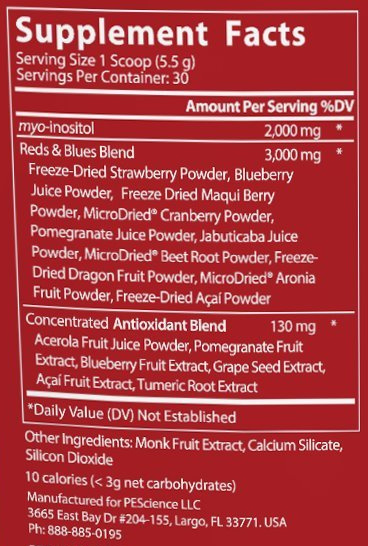


Comments and Discussion (Powered by the PricePlow Forum)